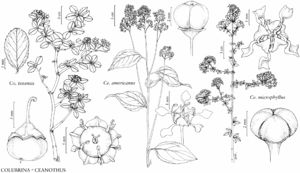Colubrina
Mém. Fam. Rhamnées, 61, plate 4, fig. 3. 1826.
| Taxon | Illustrator ⠉ | |
|---|---|---|
 | Ceanothus microphyllus Ceanothus americanus Colubrina texensis | Yevonn Wilson-Ramsey Yevonn Wilson-Ramsey Yevonn Wilson-Ramsey |
Shrubs or trees, unarmed [armed with thorns]; bud-scales present at least on short-shoots. Leaves persistent or deciduous, alternate [opposite], sometimes fascicled on short-shoots; blade not gland-dotted; pinnately veined or 3-veined from base (acrodromous). Inflorescences axillary, usually cymes, thyrses, or fascicles, rarely flowers solitary; peduncles and pedicels not fleshy in fruit. Pedicels present. Flowers bisexual; hypanthium hemispheric, 2–3 mm wide; sepals 5, spreading, brown to greenish, ovate-triangular to triangular, keeled adaxially; petals 5, greenish or yellowish to creamy white, ± hooded, spatulate or obovate, clawed; nectary fleshy, adnate to and sometimes ± filling hypanthium; stamens 5; ovary 1/2-inferior to inferior, 3 (–4) -locular; styles 3, connate proximally. Fruits capsules, sometimes tardily dehiscent, 3-locular.
Distribution
North America, Mexico, Central America, South America, se Asia, Indian Ocean Islands (Madagascar), Pacific Islands (Hawaii), widely
Discussion
Species ca. 30 (8 in the flora).
Branches of some Colubrina species are rigid but rarely produce thorns. Those of C. californica have been described as spinescent or subspinescent, alluding to short branches that sometimes are attenuate to relatively sharp points, but these are not the same as the clearly defined thorns that occur in other genera of the family.
Selected References
Lower Taxa
Key
| 1 | Leaf blade margins entire, mucronulate to obscurely serrulate, or crenulate. | > 2 |
| 2 | Leaf blades 1–2.5(–3.5) cm; Arizona, California, Nevada. | Colubrina californica |
| 2 | Leaf blades 4–15 cm; Florida. | > 3 |
| 3 | Leaf blade abaxial surfaces tawny-tomentose, adaxial surfaces villous-strigose, glabrescent, secondary veins relatively straight, 6–12 pairs; inflorescences 20–50(–70)-flowered; peduncles 8–15 mm. | Colubrina cubensis |
| 3 | Leaf blade abaxial surfaces sparsely strigose or red-brown tomentose, glabrescent or persistently tomentose on veins, adaxial surfaces glabrous or tomentose and glabrescent, secondary veins arcuate, (4–)5–9 pairs; inflorescences 8–30-flowered; peduncles 1–10 mm. | > 4 |
| 4 | Leaves deciduous, blades herbaceous, 4–9 cm, abaxial surfaces sparsely strigose, glabrescent, adaxial surfaces glabrous; peduncles 1–7 mm. | Colubrina elliptica |
| 4 | Leaves persistent, blades subcoriaceous, 5–15 cm, both surfaces tomentose, abaxial glabrescent except persistently tomentose on veins, adaxial glabrescent; peduncles (3–)5–10 mm. | Colubrina arborescens |
| 1 | Leaf blade margins serrate, serrulate, or crenate-serrate. | > 5 |
| 5 | Shrubs, erect to sprawling or clambering; leaf blade surfaces glabrous or glabrate; Florida. | Colubrina asiatica |
| 5 | Shrubs or trees, erect, (rarely clambering in C. greggii); leaf blade surfaces (one or both) hairy; sc, sw United States. | > 6 |
| 6 | Leaf blades 1–3(–4) cm, margins with 2–20 teeth per side. | > 7 |
| 7 | Leaf blades (1–)3–4 cm, margins with 10–20 teeth per side; inflorescences fascicles, 2–4(–7)-flowered, or flowers solitary, peduncles absent. | Colubrina texensis |
| 7 | Leaf blades 1–2.5(–3.5) cm, margins with 2–7 teeth per side; inflorescences usually cymes or thyrses, 2–12-flowered, sometimes flowers solitary, peduncles 1–2 mm. | Colubrina californica |
| 6 | Leaf blades 3–12 cm, margins with 40–100 teeth per side. | > 8 |
| 8 | Leaf blades 3–7.5 cm, margins with 40–70 teeth per side; inflorescences 6–15-flowered, peduncles 2–8 mm. | Colubrina stricta |
| 8 | Leaf blades (3–)4–12 cm, margins with 50–100 teeth per side; inflorescences (10–)20–40-flowered; peduncles 5–20 mm. | Colubrina greggii |